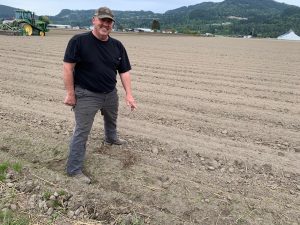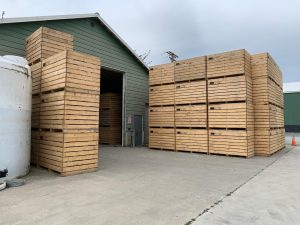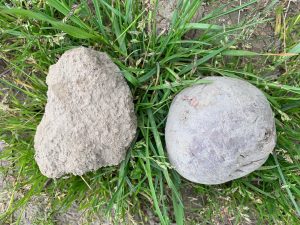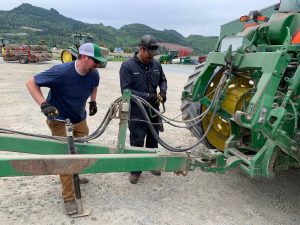It’s a good bet you already appreciate the bounty of the Skagit Valley. Who doesn’t look forward to their first bowl of summer berries or smile at the flower fields in spring? Take a moment to learn about agriculture in Skagit County and you will love this unique area just a little more.
 Skagit Valley Assets
Skagit Valley Assets
There are reasons local farmers refer to this valley between the Cascades and Puget Sound as “magic Skagit.” A rare combination of maritime climate, abundant water and fertile soil places Skagit County “firmly in the upper echelon of agricultural producing counties in the U.S,” says a report by Washington State University. In addition, the valley’s latitude yields 17 hours of daylight at the summer solstice.
Moisture patterns are ideal too. “Rain in spring and early summer followed by a drier period is perfect for growing and drying seed,” notes Allen Rozema, executive director of Skagitonians to Preserve Farmland. It also means berries ripen slowly, resulting in sweeter fruit.

Local crops include berries; flowers and bulbs; row veggies, like those in the brassicas family including brussels sprouts, cauliflower and broccoli; potatoes; and vegetable seed. Records kept by Don McMoran, director of WSU’s Skagit County Extension, highlight the success of local farmers. For example, Skagit vegetable seed is marketed worldwide. The valley produces about 25% of the world’s cabbage and beet seed, and 8% of the world’s spinach seed. More tulip and daffodil bulbs are produced here than in any other U.S. county.
Careful Strategy Required
Farming may seem like a simple pursuit. In truth it’s just the opposite. To illustrate the point, consider the array of crops raised here. Market fluctuations and the desire to grow food for residents are behind some of the variety, but the health of the soil is even more important.
Allen explains that seed and vegetable crops must be located and rotated strategically to minimize problems. Seed crops require isolation to prevent cross-pollination. “Spinach is on about a 12-year rotation,” Allen says, “due to a fungus that can persist in the soil.” Potatoes are on at least a three-year rotation. Annual brassica crops are swapped in since they discourage parasites and reduce the need for hazardous chemicals. Grasses are useful for nourishing the soil, but they are grown for a three-year period.
You can appreciate why farmers plan so carefully and cooperate with each other: no one has enough land to rotate their crops without help. Farmers used to gather before planting in a massive wheeling and dealing session called “pinning,” not unlike the NFL draft. They mapped out available land, drew numbers to determine which farmer chose first, and suddenly each grower had their fields for the year—some their own, some not. Pinning just went all-electronic in 2020.

Farmers Love to Farm
According to Don McMoran and Allen Rozema, magic Skagit has another asset—the tenacity of its growers. Many are third or fourth generation family farmers with ancestors from Scandinavia, Japan and other corners of the globe, and their long-term success is testament to a love of farming. “Skagit farmers are hardworking, intelligent and they flat out get the job done often with little recognition for their contribution to society,” says Don.
Allen notes that in addition to farming expertise, growers have mechanical know-how. A visit to Morrison Farms in Mount Vernon shows that this is so. On this fourth-generation potato farm—with grains, grasses and other crops rotated in—you’ll notice many tractors, several rototillers and dozens of other pieces of equipment used to till, plant and harvest. This inventory is essential due to a short planting window. “We may have more horsepower per acre in this county than almost anywhere else. That’s not bragging, that’s how intensified our agriculture is,” explains third-generation farmer Darrin Morrison.
John Morrison (the fourth generation) and Osbaldo Vera, a 12-year employee, are constantly hooking and unhooking various implements to the tractors. “It takes about a dozen passes through the soil before it’s ready,” says John. The farmers start by lifting packed soil with a chisel plow with deadly-looking curved tines and finish with rototillers.

“Our dirt clods are about the same size as potatoes,” says Darrin. “We can’t come back through the rows after planting, so we make sure soil in the rows is fine and potatoes don’t grow in strange shapes.” It’s also important not to harvest clumps of dirt by mistake. “No one wants to buy a dirt clod at the store!” Darrin laughs.
At Morrison Farms, adaptation is key to longevity. When the last potato packing business left the valley, Darrin got together with neighboring Smith Farms to open a new packing/storing facility. The Morrisons embrace technology as well. For instance, their tractors sport GPS equipment—not because operators need navigation assistance; instead, keying in settings and pushing the button keeps rows perfectly straight. “The GPS also minimizes strain on the driver and fuel use,” explains John.
Growing through the Challenges
To say that farming faces challenges is an understatement. Pressure from development interests is a constant. Regulation is another: labor laws, environmental legislation, health and safety regulations, wildlife and water management policies. All are important to society yet may be difficult to implement or not even practical for the Skagit Valley.

But the joys of farming win out over the frustrations at Morrison Farms. “Every year you watch the crops come up and see the fruits of your labor,” says Darrin. “Each spring it’s a clean slate—you get to do it again, do it better, learn from last year.” John enjoys seeing the potato fields in bloom: the flower color tells you which varieties are growing.
Looking to the Future
Ensuring agriculture continues to thrive in the Skagit Valley benefits everyone. Farming is the leading economic engine of Skagit County, yielding about $300 million annually, according to WSU’s Don McMoran, not including agritourism. It employs thousands of workers, provides habitat for waterfowl and other animals and attracts visitors. Furthermore, open land requires minimal government support—unlike residential developments, farmland generates more revenue than it costs.
When you catch your first soothing glimpse of the open fields heading north on I-5, when you’re cooking fresh broccoli you bought from a farm stand or when visiting friends gasp at the sight of the flower fields, Skagit Valley agriculture is enhancing your life.
That’s worth knowing about.
Find out more at the WSU Extension website and at Skagitonians to Preserve Farmland. Take a Talking Fields tour with your family, and plan to join in one or more of Skagit County’s festivals.






































